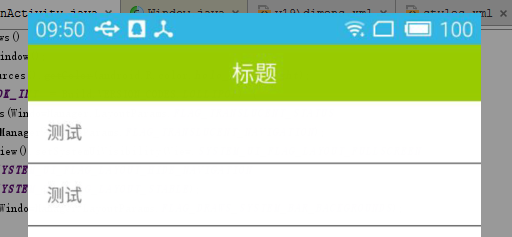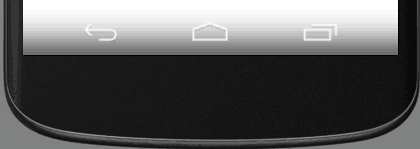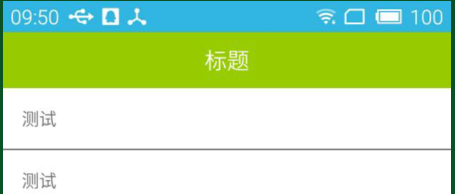
首先现分清楚哪部分是状态栏,哪部分是导航栏
状态栏StatusBar如下

导航栏NavigationBar如下

如何实现?
1.)首先实现全屏
第一种:继承主题特定主题
在Android API 19以上可以使用****.TranslucentDecor***有关的主题,自带相应半透明效果,Theme.Holo.NoActionBar.TranslucentDecor和Theme.Holo.Light.NoActionBar.TranslucentDecor两种主题为新增加的,所以要新建values-v19文件夹并创建styles文件添加如下代码
<style name="AppBaseTheme" parent="android:Theme.Holo.Light.NoActionBar.TranslucentDecor"><!-- Customize your theme here. --> </style>第二种:在activity中采用代码的方式
if (Build.VERSION.SDK_INT >= Build.VERSION_CODES.KITKAT) {//透明状态栏window.addFlags(WindowManager.LayoutParams.FLAG_TRANSLUCENT_STATUS);//透明导航栏window.addFlags(WindowManager.LayoutParams.FLAG_TRANSLUCENT_NAVIGATION);}Android 5.0 以上也可以使用下面的代码实现全屏if (Build.VERSION.SDK_INT >= Build.VERSION_CODES.LOLLIPOP) {window.clearFlags(WindowManager.LayoutParams.FLAG_TRANSLUCENT_STATUS | WindowManager.LayoutParams.FLAG_TRANSLUCENT_NAVIGATION);window.getDecorView().setSystemUiVisibility(View.SYSTEM_UI_FLAG_LAYOUT_FULLSCREEN | View.SYSTEM_UI_FLAG_LAYOUT_HIDE_NAVIGATION | View.SYSTEM_UI_FLAG_LAYOUT_STABLE);window.addFlags(WindowManager.LayoutParams.FLAG_DRAWS_SYSTEM_BAR_BACKGROUNDS);}全屏效果
不难发现此时状态栏占有的位置消失,和app的布局叠在一起了,接下来解决这个问题
2.)解决状态栏占位问题
第一种:主题添加如下设置
<item name="android:fitsSystemWindows">true</item>第二种:activity layout根目录添加下面代码
android:fitsSystemWindows="true"第三种:通过Java代码设置
rootview.setFitsSystemWindows(true);fitsSystemWindows只作用在sdk>=19的系统上就是高于4.4的系统,这个属性可以给任何view设置,只要设置了这个属性此view的所有padding属性失效.只有在设置了透明状态栏(StatusBar)或者导航栏(NavigationBar)此属性才会生效,

3.)状态栏导航栏设置背景色
4.4以上的可以采用修改contentView的背景色,或者动态添加一个view到contentView上
if (Build.VERSION.SDK_INT >= Build.VERSION_CODES.KITKAT) { //透明状态栏 window.addFlags(WindowManager.LayoutParams.FLAG_TRANSLUCENT_STATUS); //透明导航栏 window.addFlags(WindowManager.LayoutParams.FLAG_TRANSLUCENT_NAVIGATION); //设置contentview为fitsSystemWindows ViewGroup contentView = (ViewGroup) findViewById(android.R.id.content); View childAt = contentView.getChildAt(0); if (childAt != null) {childAt.setFitsSystemWindows(true); } //给statusbar着色 View view = new View(this); view.setLayoutParams(new ViewGroup.LayoutParams(ViewGroup.LayoutParams.MATCH_PARENT, getStatusBarHeight(this))); view.setBackgroundColor(color); contentView.addView(view);}动态获取StatusBarHeight函数如下 /*** 获取状态栏高度** @param context context* @return 状态栏高度*/ private static int getStatusBarHeight(Context context) {// 获得状态栏高度int resourceId = context.getResources().getIdentifier("status_bar_height", "dimen", "android");return context.getResources().getDimensionPixelSize(resourceId); }动态获取NavigationBarHeight函数如下 /*** 获取导航栏高度** @param context context* @return 导航栏高度*/ public static int getNavigationBarHeight(Context context) {int resourceId = context.getResources().getIdentifier("navigation_bar_height", "dimen", "android");return context.getResources().getDimensionPixelSize(resourceId); }然后Android5.0以上谷歌提供了新的api可以更新状态栏和导航栏的背景色 if (Build.VERSION.SDK_INT >= Build.VERSION_CODES.LOLLIPOP) { window.clearFlags(WindowManager.LayoutParams.FLAG_TRANSLUCENT_STATUS | WindowManager.LayoutParams.FLAG_TRANSLUCENT_NAVIGATION); window.getDecorView().setSystemUiVisibility(View.SYSTEM_UI_FLAG_LAYOUT_FULLSCREEN | View.SYSTEM_UI_FLAG_LAYOUT_HIDE_NAVIGATION | View.SYSTEM_UI_FLAG_LAYOUT_STABLE); window.addFlags(WindowManager.LayoutParams.FLAG_DRAWS_SYSTEM_BAR_BACKGROUNDS); //设置状态栏颜色 window.setStatusBarColor(color); //设置导航栏颜色 window.setNavigationBarColor(color); ViewGroup contentView = ((ViewGroup) findViewById(android.R.id.content)); View childAt = contentView.getChildAt(0); if (childAt != null) {childAt.setFitsSystemWindows(true); }// contentView.setPadding(0, getStatusBarHeight(this), 0, 0);}这样总体效果就实现了
4.)贴出整体java代码实现方式
private void initWindows() {Window window = getWindow();int color = getResources().getColor(android.R.color.holo_blue_light);if (Build.VERSION.SDK_INT >= Build.VERSION_CODES.LOLLIPOP) { window.clearFlags(WindowManager.LayoutParams.FLAG_TRANSLUCENT_STATUS | WindowManager.LayoutParams.FLAG_TRANSLUCENT_NAVIGATION); window.getDecorView().setSystemUiVisibility(View.SYSTEM_UI_FLAG_LAYOUT_FULLSCREEN | View.SYSTEM_UI_FLAG_LAYOUT_HIDE_NAVIGATION | View.SYSTEM_UI_FLAG_LAYOUT_STABLE); window.addFlags(WindowManager.LayoutParams.FLAG_DRAWS_SYSTEM_BAR_BACKGROUNDS); //设置状态栏颜色 window.setStatusBarColor(color); //设置导航栏颜色 window.setNavigationBarColor(color); ViewGroup contentView = ((ViewGroup) findViewById(android.R.id.content)); View childAt = contentView.getChildAt(0); if (childAt != null) {childAt.setFitsSystemWindows(true); }} else if (Build.VERSION.SDK_INT >= Build.VERSION_CODES.KITKAT) { //透明状态栏 window.addFlags(WindowManager.LayoutParams.FLAG_TRANSLUCENT_STATUS); //透明导航栏 window.addFlags(WindowManager.LayoutParams.FLAG_TRANSLUCENT_NAVIGATION); //设置contentview为fitsSystemWindows ViewGroup contentView = (ViewGroup) findViewById(android.R.id.content); View childAt = contentView.getChildAt(0); if (childAt != null) {childAt.setFitsSystemWindows(true); } //给statusbar着色 View view = new View(this); view.setLayoutParams(new ViewGroup.LayoutParams(ViewGroup.LayoutParams.MATCH_PARENT, getStatusBarHeight(this))); view.setBackgroundColor(color); contentView.addView(view);} }总结: